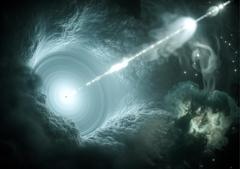URL: https://www.desy.de/news/news_search/index_eng.html
Breadcrumb Navigation
DESY News: Astroparticle physics to become research division at DESY
News
News from the DESY research centre
Astroparticle physics to become research division at DESY
DESY is expanding its activities for the exploration of the high-energy universe. As the new year begins, the research centre, which is a member of the Helmholtz Association, is setting up a new research division for astroparticle physics. The director in charge of astroparticle physics will be Christian Stegmann, who is also the head of DESY’s Zeuthen site. This means that in future DESY will have four research divisions: Accelerators, Photon Science, Particle Physics and Astroparticle Physics.

Cosmic particle accelerators like blazars (artist's impression) are typical objects for multimessenger astronomy. Credit: DESY, Science Communication Lab
Astroparticle physics studies high-energy particles from outer space that originate in high-energy phenomena such as supernova explosions and active galactic nuclei. It aims to gain a fundamental understanding of the role of high-energy particles and processes involved in the evolution of the universe, thereby providing important foundations for the search for dark matter and physics beyond the Standard Model of particle physics. It is now possible, for the first time, to measure all the different cosmic messengers – from cosmic rays, through gamma radiation and cosmic neutrinos, to gravitational waves – and to combine this information with observations made in classical astronomy, to paint a new picture of the high-energy universe. The emerging field of such combined observations of different “messengers” is called multimessenger astronomy.

Some of the staff of the new research division astroparticle physics. Credit: DESY
Within the new astroparticle physics research division, a particular scientific focus lies with the multimessenger programme. Apart from the scientific activities, DESY is setting up an international graduate school for promoting young talents in multimessenger astronomy, sponsored by the Helmholtz Association, in collaboration with partners which include the Humboldt University in Berlin, the University of Potsdam and Israel’s Weizmann Institute.
Stegmann is convinced that, “We are on the threshold of a golden age in multimessenger astronomy. And the breath-taking speed with which spectacular findings have been made in recent years means that launching the new research division of astroparticle physics is a step into the future for DESY. I am very pleased to be in charge of this very active division and to be supervising the next results as its director, results that will contribute to our understanding of the structure of matter, from the universe down to the tiniest elementary particles, and to continuing to develop science in Germany.”
https://astroparticle-physics.desy.de



